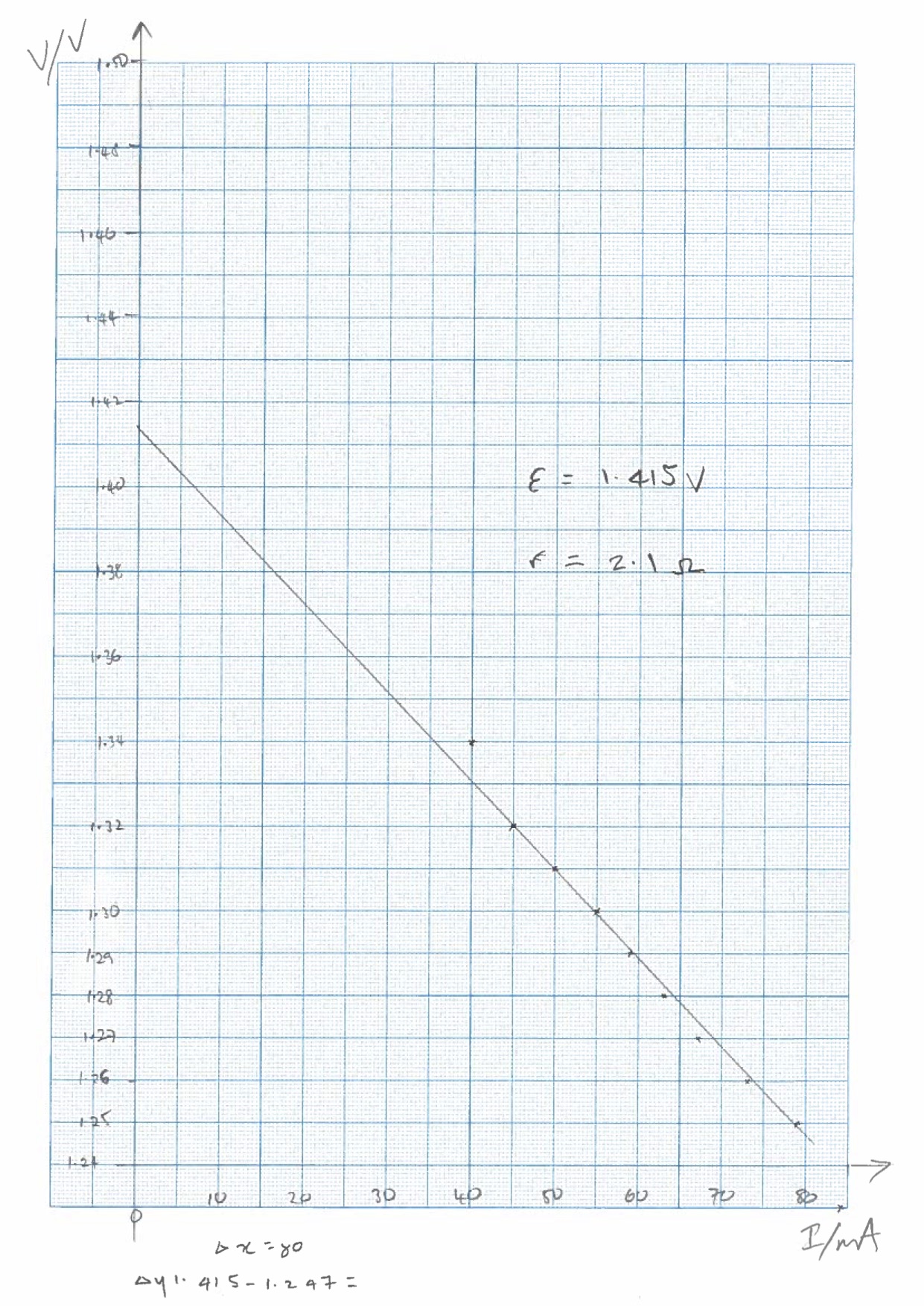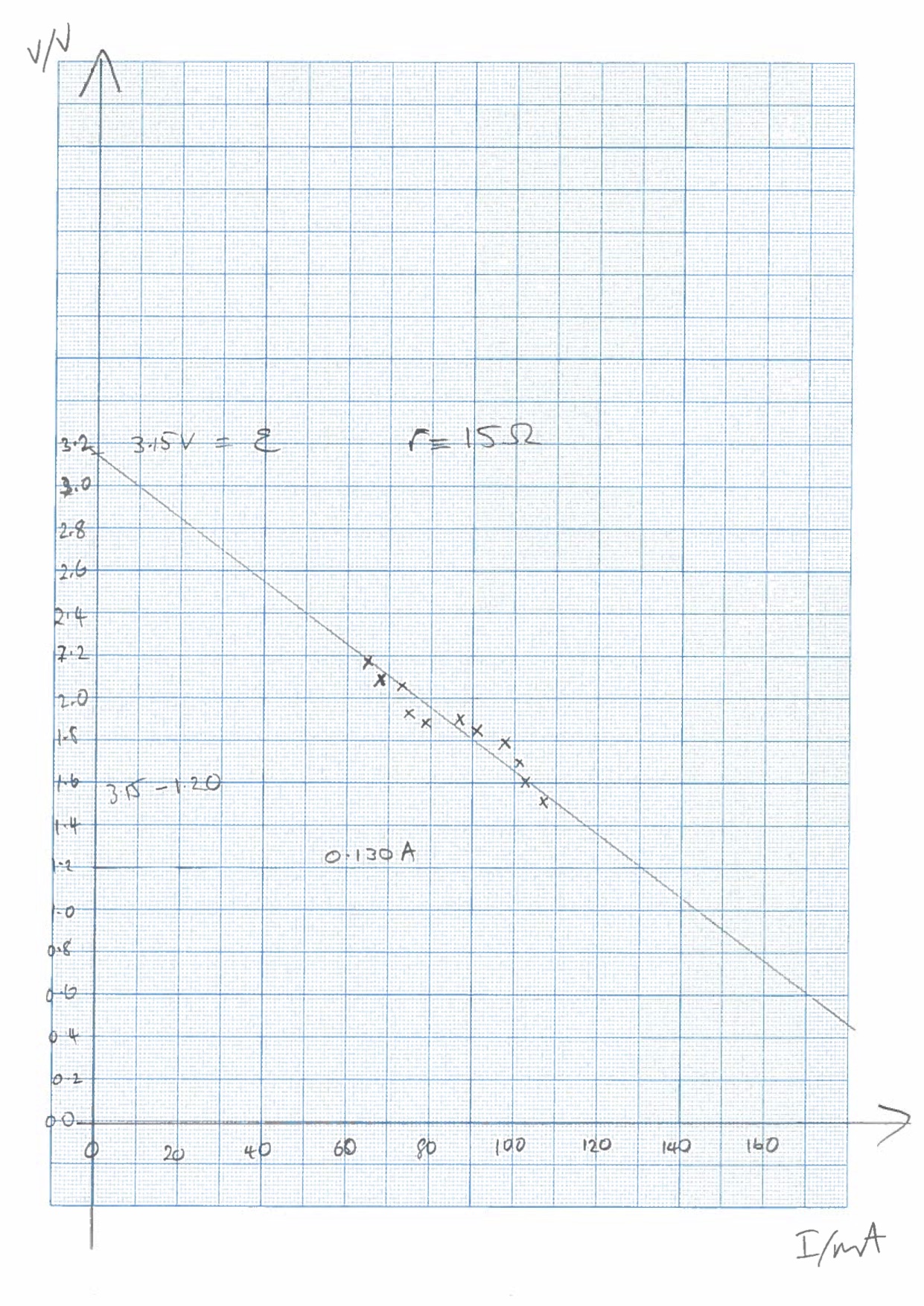
All the new specifications include “measure the internal resistance of a cell” as one of the practicals. This is probably a new bit of physics for your students, and although the practical is straightforward to set up, collecting and processing the data is more of a challenge. Comparing two different types of cell, as shown in this film, can make the practical more interesting, with potential for differentiation by ability.
The film starts (to 1:24) with the theory which you’ll probably introduce to students before carrying out the practical.
From 1:30 onwards, the film illustrates how you might go about conducting the practical with conventional cells, and also with a button cell (watch battery).
Christina and Alom do several things in the film to limit the current so the cell doesn’t overheat: they use a limiting resistor, start with low currents, and connect the circuit only momentarily. This represents safe working practice, but heating the cell would also affect the resistance we’re trying to measure.
We used a 10 Ω resistor to limit the current in the circuit. A simple fixed resistor would do, but make sure it can handle the maximum power you expect in the circuit – a few Watts. We didn’t have such a resistor to hand for filming, hence the huge switchable resistance box.
To vary the current to get multiple readings we used an old rheostat, rated at about 16 Ω. In practice anything with a range up to 50 Ω or so should work. It’s also possible to use a range of different fixed resistors, or a switchable resistance box.
Digital or analogue voltmeters or ammeters could be used instead of multimeters, but as Christina points out in the film, the use of multimeters is a skill your students will need to develop anyway. Students will need to select the most appropriate range, which is likely to be 20 V DC for the voltmeter and 200 mA DC for the ammeter (taking care to convert back to amps when processing the data).
Alom’s multimeter films may be dull, but they’ve had a third of a million views so… they may have some redeeming merit. Click through to YouTube or to maximise the film from these tiny windows:
Working in pairs, this experiment can be be done very quickly. Systematic data are nice, but as long as there’s a good spread of data points across the whole range of currents, students should get a good result.

From our data, we arrived at:
EMF = 1.415 V
Internal resistance = 2.10 Ω
We would normally expect an AA cell to have an EMF of about 1.5 V and an internal resistance of about 1 Ω. Ours was old and cheap, which probably explains our results: it’s worth noting that poorer-quality cells can make for a more interesting experiment!
You might ask your students:
Christina mentions tolerance at 4’11”, which is a concept with which students may not be familiar. All components have a stated manufacturer’s tolerance, which notes the ±% range which might be expected when the component is in normal use.
We used a standard CR2032 watch battery. The readings for this sort of cell vary much more wildly than for an AA cell. We’d assumed this is due to internal heating of the cell, but in writing these notes we’ve started to wonder if it’s more about the chemistry that’s going on inside – if there’s a limit to the reaction rate, that would explain why the voltage drops away rapidly (particularly with high current drain cases), before the cell recovers after ‘resting.’ Comments welcome, and for now we’ll move on…
Taking photos of the meters is one way of dealing with rapidly-changing readings. Another approach would be to use analogue meters, which can be easier to read by eye.
At 6’09” you’ll see Christina using a ‘best fit’ ruler – a clear ruler with a slot through the middle. We recommend these! Our results:

With the increased uncertainty in the readings, Alom suggests repeating the whole experiment twice. Each repeat could be plotted onto the same axes and the gradients and y-intercepts compared. Students could then find the mean EMF and internal resistance, together with their associated uncertainties.
We would normally expect a 3 V cell to have an EMF of about 3 V, and an internal resistance which is much higher than the AA cell – which indeed is what we found, measuring an internal resistance of 15 Ω.
You might ask your students:
Some teachers like to challenge their students further by investigating the EMF and internal resistance of a cell made with copper and zinc electrodes and an item of fruit or a vegetable, for example: a ‘potato battery.’ Further guidance on this can be found at the Practical Physics website. Cutting the potato into different shapes can make for an interesting comparison.
At the time of writing, the exam boards appear to agree that this practical might be used to address, in whole or in part:
You can likely prioritise other CPACs should you so choose. There are some more notes on this in the draft student worksheet, below.
We’ve drafted a student worksheet for this practical, which you may find useful as a starting point:
As ever, no single film can encompass everything one might wish to say about a practical. Please, leave comments with your thoughts about the approach we’ve taken, and your suggestions for alternatives or improvements.
Hello there, why do we not need to decrease the resistance of the rheostat in equal intervals? Thank you:) Reply
Lionel Coleman says:If you are plotting a graph anticipating a straight line of best fit (LOBF) then having set intervals is not absolutely necessary as you are averaging the relationship by drawing a LOBF. Ideally of course you would still have a good scatter of data points along the LOBF in order to draw a good one so best practice is to leave your equipment set up until you have plotted the graph to see if you need to take some more measurements to “fill in the gaps” Reply
Obj Ifunanya says: Like to see the table of the graph Reply ballslmao says: OMG we gotz the exact sAMES vaaluess. 111… wow ReplyThis site uses Akismet to reduce spam. Learn how your comment data is processed.
This site uses cookies. By continuing to browse the site, you are agreeing to our use of cookies.
We may request cookies to be set on your device. We use cookies to let us know when you visit our websites, how you interact with us, to enrich your user experience, and to customize your relationship with our website.
Click on the different category headings to find out more. You can also change some of your preferences. Note that blocking some types of cookies may impact your experience on our websites and the services we are able to offer.
Essential Website CookiesThese cookies are strictly necessary to provide you with services available through our website and to use some of its features.
Because these cookies are strictly necessary to deliver the website, refusing them will have impact how our site functions. You always can block or delete cookies by changing your browser settings and force blocking all cookies on this website. But this will always prompt you to accept/refuse cookies when revisiting our site.
We fully respect if you want to refuse cookies but to avoid asking you again and again kindly allow us to store a cookie for that. You are free to opt out any time or opt in for other cookies to get a better experience. If you refuse cookies we will remove all set cookies in our domain.
We provide you with a list of stored cookies on your computer in our domain so you can check what we stored. Due to security reasons we are not able to show or modify cookies from other domains. You can check these in your browser security settings.
Check to enable permanent hiding of message bar and refuse all cookies if you do not opt in. We need 2 cookies to store this setting. Otherwise you will be prompted again when opening a new browser window or new a tab.
Click to enable/disable essential site cookies. Google Analytics CookiesThese cookies collect information that is used either in aggregate form to help us understand how our website is being used or how effective our marketing campaigns are, or to help us customize our website and application for you in order to enhance your experience.
If you do not want that we track your visit to our site you can disable tracking in your browser here:
Click to enable/disable Google Analytics tracking. Other external servicesWe also use different external services like Google Webfonts, Google Maps, and external Video providers. Since these providers may collect personal data like your IP address we allow you to block them here. Please be aware that this might heavily reduce the functionality and appearance of our site. Changes will take effect once you reload the page.
Google Webfont Settings:
Click to enable/disable Google Webfonts.Google Map Settings:
Click to enable/disable Google Maps.Google reCaptcha Settings:
Click to enable/disable Google reCaptcha.Vimeo and Youtube video embeds:
Click to enable/disable video embeds. Other cookiesThe following cookies are also needed - You can choose if you want to allow them:
Click to enable/disable _ga - Google Analytics Cookie. Click to enable/disable _gid - Google Analytics Cookie. Click to enable/disable _gat_* - Google Analytics Cookie. Privacy PolicyYou can read about our cookies and privacy settings in detail on our Privacy Policy Page.